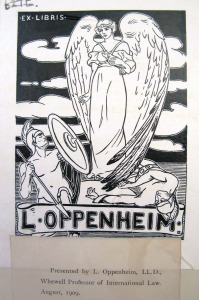
Not all the books we buy are new, and when we acquire antiquarian copies we can sometimes see from the bookplate who previously owned the book. This was the case with four volumes which recently crossed my desk in quick succession, all with beautiful and interesting bookplates:
The first one is the bookplate of Alexander Ostrowski (1893-1986). He was born in Kiev, studied in Germany and was then Professor of Mathematics at Basel – this fits with the provenance of the book containing this bookplate which was bought from a second-hand bookseller in Basel. Using dividers to represent a mathematician had been done before – see William Blake’s print of Newton, inspiration for Paolozzi’s sculpture at the British Library. I don’t know who the artist of the bookplate was but I particularly like the way the worm is depicted descending from the dividers and eating its way through the volumes at the bottom.
The owner of the second bookplate is less clear but a Google search of the name Kai Hunstadbråten brings up search results related to dentistry and specifically in Norway in the 1970s and 1980s. This makes perfect sense and explains the rather gruesome subject matter of the bookplate as a nod to the owner’s profession, with books representing the teeth in the skull being taken out by a figure resembling a dentist holding a drill.
Waldemar Zachrisson (1861-1924) was a Swedish printer who was inspired by William Morris to reform typography and book art in his Gothenburg printing house so it seems appropriate that the personal bookplate that he shared with his wife, Beda, is an intricate thing of beauty. It depicts a couple surrounded by a rough heart shape of fruit boughs, one reading a book in deep concentration while the other gazes on admiringly . The book containing this bookplate is a 19th century German language book on typesetting.

The fourth bookplate was in a book donated to the University Library by Lassa Oppenheim (1858-1919), a German jurist who came to Britain in the 1890s and became Whewell Professor of International Law at Cambridge in 1908. One might expect the bookplate of a lawyer to show the goddess Justitia but she is usually depicted holding scales whereas this winged figure is holding a dove. Perhaps this is Nike/Victoria, goddess of victory with a vanquished soldier at her feet.
If you would like to see other interesting bookplates the University Library has a number of books devoted to them. Historically, bookplates generally featured heraldic themes but the more pictorial and calligraphic ones that developed in the late 19th century and 20th century are of particular visual interest. Good early examples of these can be found in Richard Braungart’s 1922 book Das moderne deutsche Gebrauchs-Exlibris. German bookplates from the 1920s to the 1950s are covered in Hans Laut’s Exlibris-Kunst aus dem deutschsprachigen Gebiet and the 1979 book Das zeitgenössische Exlibris by František Dvořák contains good examples of postwar Czech bookplates.
Katharine Dicks





